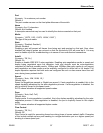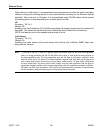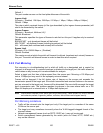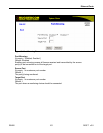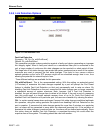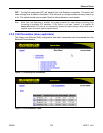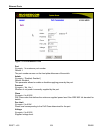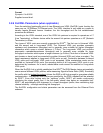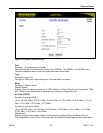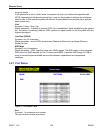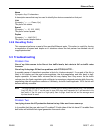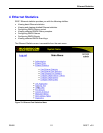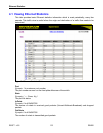
Ethernet Ports
RS400 105 ROS™ v3.5
Current
Synopsis: 0 to 65535
Supplied current level.
3.2.6 EoVDSL Parameters (when applicable)
From the switching functionality point of view Ethernet-over-VDSL (EoVDSL) ports function the
same way as 10/100Base-TX Ethernet ports. The VDSL interface is only used as a media to
transfer regular Ethernet frames. However, the link throughput and the link establishment
procedure are different.
According to the VDSL standard, one of the VDSL link partners is required to operate as a LT
(Line Termination) or Master device while the second link partner operates as a NT (Network
Termination) or Slave.
Two types of VDSL ports are currently supported by ROS
TM
. The first one is Universal VDSL
and the second one is Long-reach VDSL. The Universal VDSL port provides symmetric
upstream and downstream throughput and is generally more suitable for higher throughput
connection which spans a shorter distance (< 2.5km). The Long-reach VDSL port provides
asymmetric upstream/downstream throughput and is generally more suitable for lower
throughput connection which spans a longer distance (up to 4km). Note that a Universal VDSL
port (master or slave) must be connected to another Universal VDSL port (slave or master). The
same requirement applies to Long-reach VDSL ports as well. Connection between Universal
VDSL ports and Long-reach VDSL ports is not supported. While master/slave mode can be
modified on Universal VDSL ports, the operating mode of all Long-reach VDSL ports is pre-
determined by hardware. As a result, master/slave mode cannot be modified on Long-reach
VDSL ports.
When the EoVDSL link is initially established, the ROS
TM
EoVDSL Master device automatically
scans several different VDSL profiles, while measuring Signal-to-Noise Ratio (SNR). Eventually
the profile with the highest throughput
(where the SNR is still high enough to guarantee reliable
communication - the required SNR values are specified by the VDSL standard) will be selected
by ROS™. Even after locking onto the “optimum” profile, ROS™ will remain continuously
monitoring the signal quality and, if the link-quality should drop below an acceptable limit,
ROS™ will automatically shift downward to a lower throughput profile, thus maintaining high
channel reliability – although sacrificing link-throughput.
The EoVDSL configuration and status parameters can be accessed from the Ethernet Ports
submenu.



